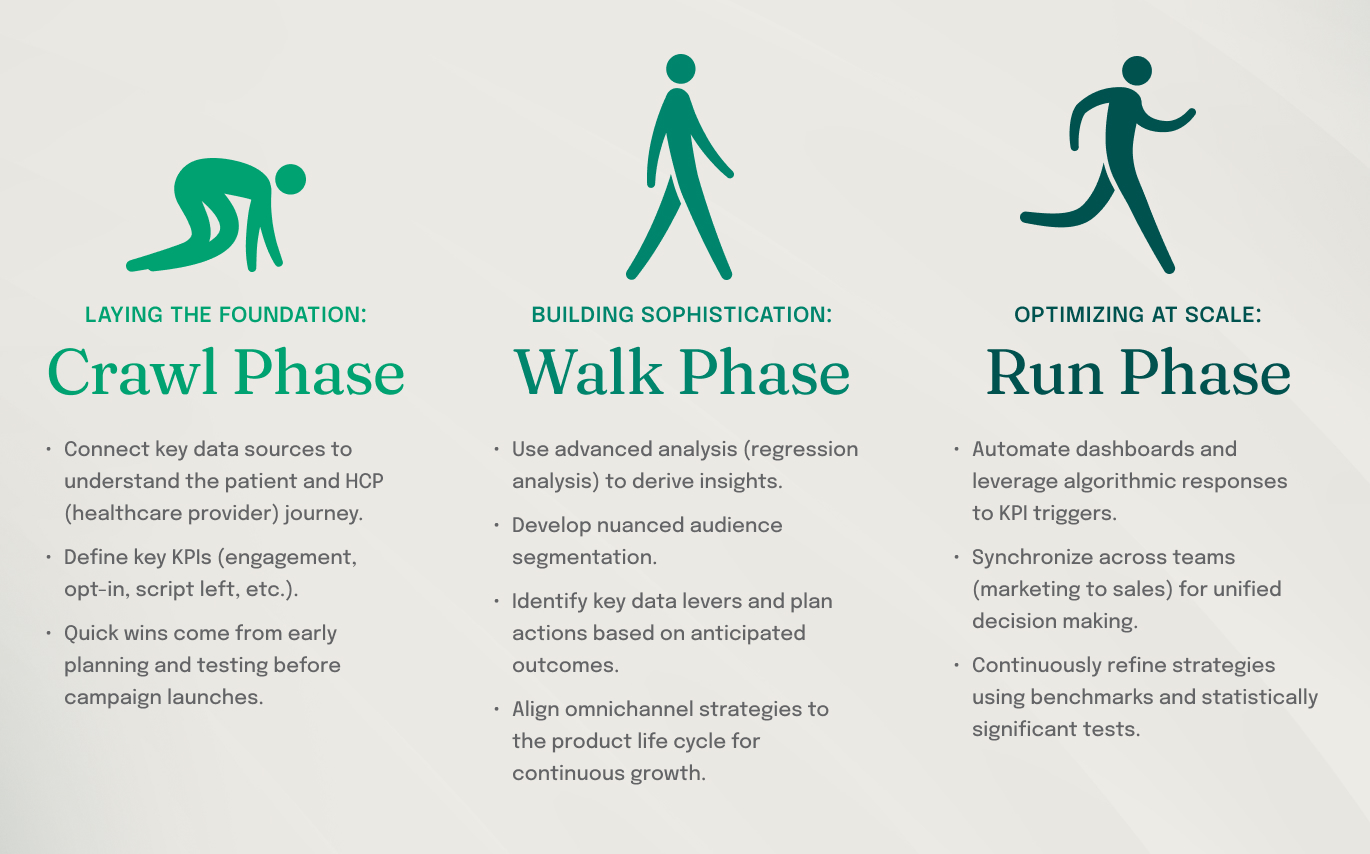Imagine delivering a perfectly seamless customer experience where every interaction is relevant, every touchpoint is optimized, and all systems are working together in harmony. This ideal vision captures our imagination, but it also raises a critical challenge for many in the life science space: Where do I start? With complexity often standing in the way, it’s easy to feel daunted or even stuck.
The good news? Success doesn’t start with perfection; it starts with progress. By focusing on actionable steps and achievable milestones, you can build momentum and see meaningful ROI.
In partnership with the marcusevans Group, MERGE’s 60-minute webinar, “Omnichannel Simplified: Practical Steps to Implement and Build Momentum,” presents a panel of industry experts offering insights to equip your team with practical strategies to move from idea to execution and turn inspiration into impact.
The conversation features:
- Luke Greenwalt, Vice President and Lead, Market Access Center of Excellence, IQVIA
- Jason Budelmann, SVP, Group Analytics, MERGE
- Pat McGloin, Managing Director, Health & Life Sciences, MERGE
Key takeaways from the discussion include:
1. Start Small With a Use Case That Matters
Implementing an omnichannel strategy can feel overwhelming, but success begins with focusing on achievable, high-impact changes. Instead of waiting for the perfect infrastructure, teams should identify a single use case—such as a specific brand, segment, or moment in the customer journey—and test and learn from it.
Says Budelmann, “When we think about omnichannel, because it’s right there in the name ‘Omni,’ we think about everything, but pragmatically you have to start with connecting the most valuable data sources together. And do it in a way where you’re going to build those longitudinal learnings.” From Budelmann’s perspective, this approach allows for controlled experimentation and clarity in results, using a minimal viable product (MVP) where you can learn and adjust quickly before spending larger resources.

2. Align KPIs to Business Outcomes
A successful omnichannel strategy isn’t about using more channels; it’s about personalization, which research shows leads to better outcomes. Teams must define what success looks like upfront, aligning KPIs with business objectives to ensure clarity and focus. However, before aligning KPIs, Budelmann emphasizes that it’s important to define the data.
“When life science organizations are in the crawl phase, we often see them focusing on impressions or sends without anchoring their metrics to individual-level data,” says Budelmann. “Even at the individual level, it’s important to ask whether you’re analyzing simply website visitors or sessions. Organizing data by its granularity is critical. For example, when evaluating a click-through rate, determine whether it’s based on unique opens or total opens, as this distinction impacts how you assess performance.”
This level of alignment allows for deeper and more actionable insights. As Greenwalt put it, “Omnichannel success depends on defining KPIs that matter. Too many variables can obscure the signal from the noise. Focus on metrics that directly tie to your business goals, and use agile feedback loops to optimize quickly.”
3. Let the Data Lead You, Not Paralyze You
The fear of imperfect data often leads to hesitation when shaping omnichannel strategies, but waiting for flawless data can stall progress. Instead, organizations should use the data they have to guide actionable decisions while refining their approach over time. Budelmann shared a pragmatic perspective, noting, “If creative is working better or a particular channel is working better than anticipated, what’s that next play we want to follow up with? Pre-script it so as to avoid losing time in ideation.” Controlled testing and iterative refinement provide the clarity needed to make consistent progress without being paralyzed by uncertainty.
Greenwalt also echoed the importance of digging deeper into metrics and explained how relying only on surface-level data, like filled prescriptions, can be misleading. “If you’re only measuring filled prescriptions, you’re missing out on a tremendous amount of activity,” he said. Drawing a parallel to understanding batting averages in baseball, Greenwalt highlighted the value of using longitudinal data, which reveals missed opportunities by identifying signals like physicians attempting to prescribe or patients trying to fill treatments, even if unsuccessful. By broadening their analysis and focusing on these hidden insights, teams can make smarter, more informed decisions that drive real momentum.
4. Build an Agile Measurement Loop
To succeed with omnichannel, organizations need to establish an agile measurement loop that fosters rapid learning and adaptability. “To ensure alignment with the ultimate strategy, it’s crucial to involve stakeholders early in the process,” said McGloin. “Engage different groups from the beginning and establish steering committees to maintain a consistent cadence of cross-functional collaboration. Staying closely aligned throughout the journey is essential for achieving long-term success.”
This involves tracking meaningful data that aligns with specific objectives and setting up feedback mechanisms to evaluate and optimize strategies on the go. Budelmann underscored this, saying, “Momentum comes from building that testing and iterative culture.” By testing new approaches and using insights from both successes and shortfalls, teams can refine their tactics in real time, driving continuous improvement and efficiency.
Agile measurement loops also rely on breaking down complex data to focus on what truly matters for actionable outcomes. Greenwalt highlighted this when discussing evaluating performance, noting, “If you’re not actually looking at the right signals in the data, it makes it difficult to know if it’s a good campaign or not.” By prioritizing the right metrics and avoiding unnecessary complexity, teams can ensure their feedback systems deliver clarity and actionable insights. This clarity empowers organizations to make smarter decisions, enabling them to adapt quickly and maintain campaign relevance in an evolving market landscape.
To catch all the valuable insights from our panel discussion, check out the webinar recording!

